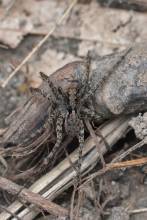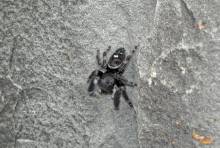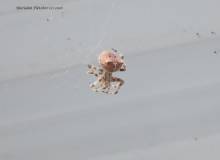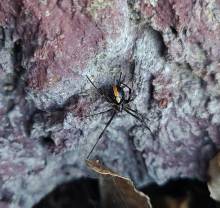Maybe we’re still thinking about Halloween, or maybe we’re noticing more spiders this time of year because of the dropping temperatures outside. Either way, we want to bring you an eight-legged version of our Mammoth Lakes Wildlife Highlight!
In this article, we’ll talk about some of the most common types of spiders you may see in Mammoth and the important role they play in our Eastern Sierra ecosystem!
A caveat before we get started!
We know that spiders are not everyone’s cup of tea. And an entire article dedicated to them may give you the creepy-crawly impression that Mammoth Lakes is full of spiders. Let us quell your fears by saying that because we live in a dry, cold climate, spiders are not as common as in many other parts of California. In fact, it’s very rare to even see spiders during the colder winter months, because their lifecycle doesn’t extend for more than a year or they go into a state of spider hibernation (spidernation, if you will.)
That being said, these little critters are an important part of the natural ecosystem up here in the mountains. And knowing more about them can give you a newfound appreciation and respect for our arachnid neighbors. So, let’s take a look at some common species!
Banded Garden Spider (Argiope trifasciata)
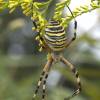
This delightfully named spider can be found during summers in Mammoth, when they’re able to spin their webs between stalks of grass, sage brush, or flowers in the garden. You can identify them by their beetle-juice-like striped coloring and elongated oval abdomen. These spiders are the least likely to come into contact with humans, and they probably won’t bite unless they’re a female protecting her eggs.
One amazing fact about the banded garden spider is that they are expert sunbathers. Usually, you’ll see them hanging out upside down with their bellies facing south. This allows them to use their darker underside to absorb UV rays to keep them warm. When the sun gets a bit too intense, they will respin their webs at a tilt so that they can achieve the perfect sunbathing position.
Why we love banded garden spiders: these well-dressed spiders aren’t only a welcome sign of summer, but they also play an important role in managing our mosquito, gnat, and fly populations.
Thin-Legged Wolf Spider (Pardosa californica)
Wolf and spider are two words that tend to make people recoil. But, these arachnids are not to be feared! Like most hunting spiders, they have enough venom to stop small insects in their tracks. But the unusual bite in a human will feel like nothing more than a bee sting (unless the person is allergic.)
You can identify the wolf spider here in Mammoth by their fused body, meaning that they don’t have a clear break between their head and abdomen. Their colors range from dark brown to sandy gray, and they usually have two dark lines running down the sides of their body.
Unlike many spider families, the wolf spider doesn’t spin a web. Instead, they track down and hunt their prey using incredible eyesight and speed. Unfortunately, it’s their track star skills that make most humans afraid of them; they sure do know how to sprint when you’re trying to safely take them outside!
Why we love wolf spiders: There’s no doubt that these spiders are the bad boys of the arachnid world. But that’s why we love them! They keep our area free of fleas, ticks, earworms, and any other small creepy-crawlies that cross their path.
Bold Jumping Spider (Phidippus audax)
Can we call a spider cute? Because we think the bold jumping spider is definitely a cutie! Like all jumping spiders, these guys are very small, round, and fuzzy. But you can differentiate the phidippus audax from other jumping spiders by its unique white markings on the abdomen that look like a little emoji face. Like we said before, very cute!
Like the wolf spider, jumping spiders don’t spin webs to catch prey. Instead, they use those huge eyes and crazy jumping abilities to pounce on their prey. But—and this may be the cutest fact of all—they have been known to use their webs as a kind of blanket fort when they need a safe place to rest.
Why we love bold jumping spiders: Like most jumping spiders, these little arachnids don’t really like to be in our homes. But they will sometimes wander in following prey. Even so, they’re so small that they’re not very noticeable, and you can be sure that they’ll keep out ants, weevils, and moths.
Cat-faced Orb Weaver (Araneus gemmoides)
Okay, we admit it. This spider mightt make you gasp when you see it. It’s because they have a huge, hard-to-miss, cat-shaped, somewhat hairy abdomen that makes them look quite intimidating. These spiders are also called Jewel Spiders because it looks like they’re dragging around a big gemstone on their abdomen.
As you can probably guess from that RV-style rump they’ve got, the Cat-faced Orb Weaver is not a runner. Instead, they are skilled web-weavers, looking for the perfect place to set up shop and catch flying insects. They’re often most commonly seen during fall when the females seek out warm areas to lay their eggs. But don’t worry about seeing one inside. They are true outdoor cats, most often seen in garages, roof overhangs, or porch eaves.
What we love about cat-faced orb weavers: You’d be hard-pressed to find a spider web as perfect as the cat-faced orb weaver’s creation. They are true works of beauty.
Western Black Widow (Latrodectus hesperus)
Yeah, we know. This is NOT the spider you wanted to see on this list. But, the truth is, this notoriously venomous spider does live here in the Eastern Sierra, as well as in the rest of California!
While we don’t have to describe to you what this spider looks like—we’ve all seen the iconic black spider with the flashy red hourglass—one thing you may not realize is that not all black widows look the same! Young widows, for instance, are white with spots and stripes. The more they molt, the more they take on their recognizable form.
You can also identify a black widow by the web. Unlike the cat-faced orb weaver’s perfectly symmetrical web, the black widow web can look like a 3D, chaotic mess. This is because the widow web is designed to trap larger prey, even some invertebrates like lizards!
And, of course, we have to talk about that venom. Black widow bites in humans are exceedingly rare, but they are dangerous. According to Smithsonian Magazine, a widow bite is 15 times more powerful than a rattlesnake bite. That being said, a rattlesnake produces much more venom in each bite than a spider. That’s why an encounter with a widow is only considered high risk to children, elderly people, or anyone with a compromised immune system. There’s also an antivenom that can help alleviate the symptoms.
Why we love the Western Black Widow: We’ll admit it, the black widow is not one of our favorite spiders. But, these are incredible creatures who have found a way to survive in our harsh climate. Like all spiders, they help to manage other insect populations, including mosquitoes, beetles, moths, and wasps. And we do appreciate their flair for drama!
There, that wasn’t so bad!
As you can see, there are a few key spider species that live in Mammoth Lakes. But, because of our unique climate, their distribution is quite low and the majority die off during winter. And even in the summer and fall, you don’t have to worry about seeing these little guys inside. The majority of Eastern Sierra spider species prefer to live outside, where they help to control other insects that are far more dangerous, like mosquitoes. So, if you happen to see a spider during your next visit to Mammoth Lakes, give them a nod of appreciation!

